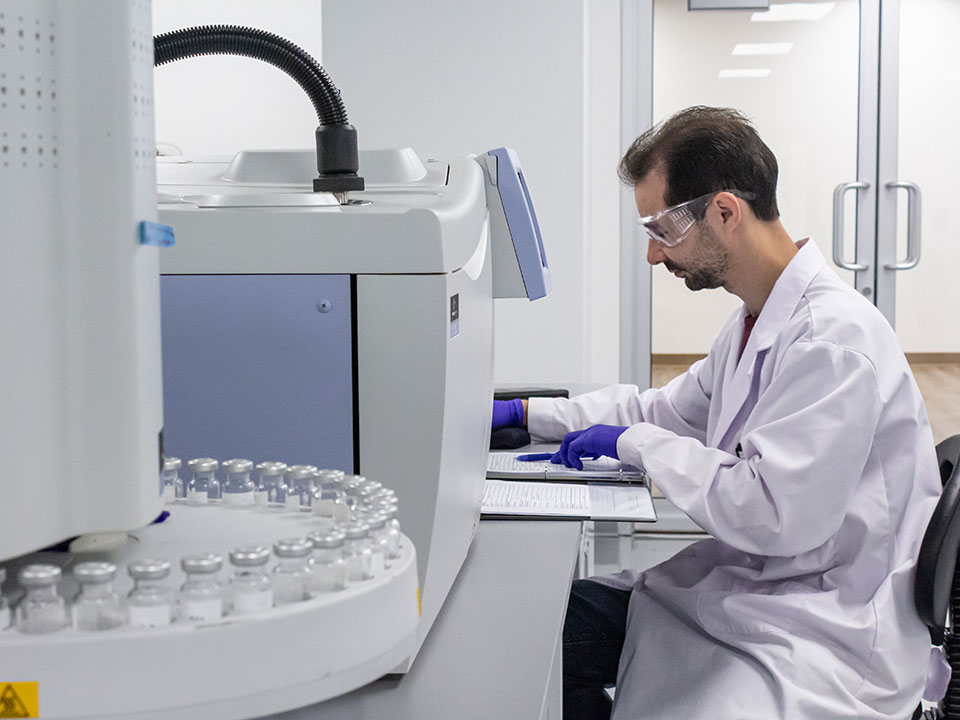Residual solvents from extraction processes rank among the critical quality-control concerns for natural health products. This machine is employed to guarantee the purity of all products
Upload new graph image
![Vitamin-mix-chromatogram[1]](https://nhplab.com/wpress/wp-content/uploads/Vitamin-mix-chromatogram1.jpg)
Additional info CHATGPT – verify and edit later
Gas Chromatography-Headspace (GC-Headspace) is an analytical technique used for the analysis of volatile and semi-volatile compounds in samples. It is particularly well-suited for the analysis of compounds that are not easily volatilized at the temperature of the GC injector, or for samples that contain non-volatile matrix components. Here’s an overview of GC-Headspace as an analytical tool:
Principle:
- Headspace Sampling:
- GC-Headspace involves the sampling of the headspace (vapor phase) above a sample that is in a sealed container.
- Volatile and semi-volatile compounds in the sample partition into the headspace, creating a representative vapor phase.
- Injection into GC:
- After a suitable equilibration time, a portion of the headspace is injected into the GC system for separation and analysis.
- Gas Chromatography:
- The injected vapor sample is separated by the gas chromatograph based on differences in volatility and interaction with the stationary phase.
- Detector:
- The separated compounds are detected by a suitable detector, such as a flame ionization detector (FID), thermal conductivity detector (TCD), or mass spectrometer (MS).
Instrumentation:
- Headspace Sampler:
- The headspace sampler is used to extract and inject the headspace vapor into the GC system.
- It may include features such as heating to control the equilibration temperature and agitation to enhance sample equilibration.
- Gas Chromatograph:
- The GC system typically includes a column oven, injector, chromatographic column, and detector(s) for compound separation and detection.
Applications:
- Pharmaceutical Analysis:
- GC-Headspace is used for the analysis of residual solvents in pharmaceutical products and packaging materials.
- Food and Beverage Analysis:
- It is employed for the analysis of volatile compounds in food and beverages, such as flavor compounds, contaminants, and aroma profiling.
- Environmental Analysis:
- GC-Headspace is used for the analysis of volatile organic compounds (VOCs) in environmental samples, such as soil, water, and air.
- Forensic Analysis:
- It is utilized in forensic laboratories for the analysis of volatile compounds in blood, urine, and other biological samples.
- Polymer and Material Analysis:
- GC-Headspace is used to analyze the off-gassing of volatile compounds from polymers and materials, including packaging materials and consumer products.
Advantages:
- Sample Preparation:
- Minimal sample preparation is required, as the analysis is performed on the headspace vapor rather than the sample itself.
- Matrix Compatibility:
- It is suitable for samples with complex matrices or non-volatile components.
- Sensitivity:
- GC-Headspace offers high sensitivity for the analysis of volatile compounds.
- Quantification:
- Quantitative analysis can be performed using appropriate calibration standards.
Challenges:
- Equilibration Time:
- Proper equilibration time is crucial to ensure representative sampling of volatile compounds from the sample headspace.
- Matrix Effects:
- Matrix effects may influence the partitioning of compounds into the headspace, affecting the accuracy and precision of the analysis.
GC-Headspace is a valuable technique in analytical chemistry, providing a robust and reliable method for the analysis of volatile and semi-volatile compounds in a wide range of sample types. Its versatility and sensitivity make it an indispensable tool in various fields, including pharmaceuticals, food and beverage, environmental science, and forensic analysis.
Recent Entries
Quick Links
Customer Service
Where to find us
3405 F.-X.-Tessier
Vaudreuil-Dorion (Québec)
Canada, J7V 5V5




